-
January
-
February
- This Week in History: February 6-12 – Lesson
- This Week in History: February 6-12 – Quiz
- This Week in History: February 13-19 – Lesson
- This Week in History: February 13-19 – Quiz
- This Week in History: February 20-26 – Lesson
- This Week in History: February 20-26 – Quiz
- This Week in History: February 27-March 5 – Lesson
- This Week in History: February 27-March 5 – Quiz
-
March
- This Week in History: March 6-12 – Lesson
- This Week in History: March 6-12 – Quiz
- This Week in History: March 13-19 – Lesson
- This Week in History: March 13-19 – Quiz
- This Week in History: March 20-26 – Lesson
- This Week in History: March 20-26 – Quiz
- This Week in History: March 27-April 2 – Lesson
- This Week in History: March 27-April 2 – Quiz
-
April
- This Week in History April 3-9 – Lesson
- This Week in History April 3-9 – Quiz
- This Week in History: April 10-16 – Lesson
- This Week in History: April 10-16 – Quiz
- This Week in History: April 17-23 – Lesson
- This Week in History: April 17-23 – Quiz
- This Week in History: April 24-30 – Lesson
- This Week in History: April 24-30 – Quiz
-
May
- This Week in History: May 1 – 7 – Lesson
- This Week in History: May 1 – 7 – Quiz
- This Week in History: May 8 – 14 – Lesson
- This Week in History: May 8 – 14 – Quiz
- This Week in History: May 15 – 21 – Lesson
- This Week in History: May 15 – 21 – Quiz
- This Week in History: May 22-28 – Lesson
- This Week in History: May 22-28 – Quiz
- This Week in History: May 29-June 4 – Lesson
- This Week in History: May 29-June 4 – Quiz
-
June
- This Week in History: June 5 – 11 – Lesson
- This Week in History: June 5 – 11 – Quiz
- This Week in History: June 12-18 – Lesson
- This Week in History: June 12-18 – Quiz
- This Week in History: June 19-25 – Lesson
- This Week in History: June 19-25 – Quiz
- This Week in History: June 26 – July 2 – Lesson
- This Week in History: June 26 – July 2 – Quiz
-
July
- This Week in History: July 3 – 9 – Lesson
- This Week in History: July 3 – 9 – Quiz
- This Week in History: July 10 – 16 – Lesson
- This Week in History: July 10 – 16 – Quiz
- This Week in History July 17 – 23 – Lesson
- This Week in History July 17 – 23 – Quiz
- This Week in History – July 24-30 – Lesson
- This Week in History – July 24-30 – Quiz
- This Week in History: July 31 – August 6 – Lesson
- This Week in History: July 31 – August 6 – Quiz
-
August
- This Week in History: August 7-13 – Lesson
- This Week in History: August 7-13 – Quiz
- This Week in History: August 14 – 20 – Lesson
- This Week in History: August 14 – 20 – Quiz
- This Week in History: August 21 – 27 – Lesson
- This Week in History: August 21 – 27 – Quiz
- This Week in History: August 28 – September 3 – Lesson
- This Week in History: August 28 – September 3 – Quiz
-
September
- This Week in History: September 4 – 10 – Lesson
- This Week in History: September 4 – 10 – Quiz
- This Week in History: September 11 -17 – Lesson
- This Week in History: September 11 -17 – Quiz
- This Week in History: September 18 – 24 – Lesson
- This Week in History: September 18 – 24 – Quiz
- This Week in History: September 25 – October 1 – Lesson
- This Week in History: September 25 – October 1 – Quiz
-
October
- This Week in History: October 2-8 – Lesson
- This Week in History: October 2-8 – Quiz
- This Week in History: October 9 –15 – Lesson
- This Week in History: October 9 –15 – Quiz
- This Week in History: October 16–22 – Lesson
- This Week in History: October 16–22 – Quiz
- This Week in History: October 23–29 – Lesson
- This Week in History: October 23 –29 – Quiz
- This Week in History: October 30 – November 5 – Lesson
- This Week in History: October 30 – November 5 – Quiz
-
November
- This Week in History: November 6 – 12 – Lesson
- This Week in History: November 6 – 12 – Quiz
- This Week in History: November 13 – 19 – Lesson
- This Week in History: November 13 – 19 – Quiz
- This Week in History: November 20 – 26 – Lesson
- This Week in History: November 20 – 26 – Quiz
- This Week in History: November 27- December 3 – Lesson
- This Week in History: November 27- December 3 – Quiz
-
December
This Week in History: May 22-28 – Lesson
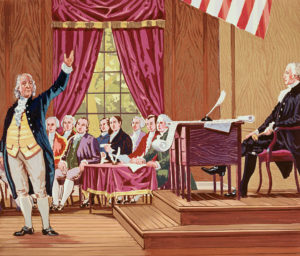
Benjamin Franklin speaking at the Constitutional Convention (Getty Images)
The Constitutional Convention and the first telegraph message.
“Certain periods in history suddenly lift humanity to an observation point where a clear light falls upon a world previously dark.” ~Anne Sullivan
May 25, 1787: The Constitutional Convention Began
Also known as the hundred-day debate, the Constitutional Convention began on this date – four years after the Revolutionary War. This important date marks the beginning of the US becoming a true Constitutional Republic.
Delegates from every state except Rhode Island convened in Philadelphia to begin deciding the fate of the Americas. George Washington, who was considered a war hero from Virginia, was elected president of the committee. Also in attendance were James Madison, who is credited as the Father of the Constitution, Alexander Hamilton, and Benjamin Franklin – the Founding Fathers.
The group met at the Pennsylvania State House for the convention, which is today known as Independence Hall. This same building was where the Declaration of Independence was drafted and the Articles of Confederation signed.
The team decided not to amend the Articles of Confederation, and instead sought to develop a new government. But no one could agree. A fierce debate went on for two months over the Virginia Plan, which had been proposed by Madison as a way to update the Articles of Confederation. However, the Committee of the Whole could not agree. On July 24, after months of arguing, the Committee of Detail was enacted to handle the drafting of the new rules.
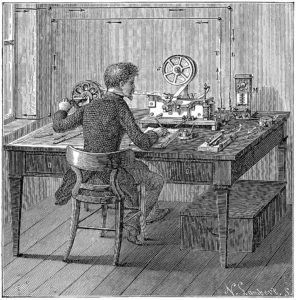
Operator receiving a message in Morse code on printing telegraph. In box under table are the wet cells (batteries) supplying electricity. Wood engraving 1887 (Photo by Universal History Archive/Getty Images)
On September 17, 1787, the United States Constitution was adopted with 39 signatures and was sent to the states for ratification.
May 24, 1844: First Telegraph Message Was Sent
Samuel Finley Breese Morse was born on April 27, 1791, in Charlestown, Massachusetts. He grew up being interested in art and electricity. In 1832, he learned of an electric telegraph designed by a French inventor and spent the next 12 years of his life trying to make a working instrument. While working on his project, he also invented Morse code, which is a way to communicate with a code delivered in dots and dashes.
On January 6, 1838, Morse’s telegraph system is demonstrated at the Speedwell Iron Works in Morristown, New Jersey where he showed how Morse code could be sent – and received – over a wire. He finally convinced Congress to pay for a telegraph line that went from Washington to Baltimore.
On May 24, 1844, with Congressmembers watching, Morse tested his prototype. He dispatched a message from the US Capitol to a railroad station in Baltimore, Maryland which was received by one of his partners, Alfred Vail. The message “What Hath God Wrought” was received and returned, forever changing the way America, and the world, communicated. Just ten years after this first line was opened, more than 20,000 miles of telegraph cable stretched across the country.
Other Notable Mentions
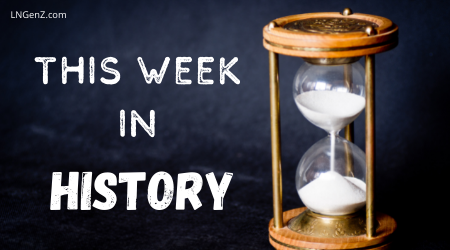
May 22, 1972: President Richard Nixon visited Moscow, the first US commander-in-chief to do so. Four days later, a pact between Nixon and Soviet Russia’s leader, Leonid Brezhnev, had the leaders pledging not to increase their nuclear arsenals.
May 22, 1947: In an effort to prevent the spread of Communism, Congress approved support for Greece and Turkey with the Truman Doctrine.
May 24, 1881: The Victoria, a small double-decked stern-wheeler, keeled over and then sank in Canada on the Thames River. There were more than 600 passengers and 182 were killed in the accident.
May 25, 1994: Alexander Solzhenitsyn, a Russian author, returned home. He had been expelled from Soviet Russia for 20 years after his writings on the Soviet prison camp system, The Gulag Archipelago, was published.
May 26, 1940: The British Expeditionary Force was trapped by German armies in France, so the Dunkirk evacuation began. Boats ferried 200,000 British as well as 140,000 French and Belgian soldiers across the English Channel.
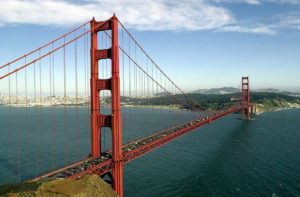
The Golden Gate Bridge (Photo By Justin Sullivan/Getty Images)
May 27, 1937: To celebrate the opening of the Golden Gate Bridge in San Francisco, California, 200,000 people walked across it for the first time.
May 28, 1961: London Lawyer Peter Berenson founded Amnesty International. Today, there are more than a million members working to free prisoners and stop torture and the death penalty.
Famous Birthdays
Arthur Conan Doyle (May 22, 1859) was born at Edinburgh, Scotland. He was the creator of the character Sherlock Holmes.
Laurence Olivier (May 22, 1907) was born in Dorking, England. He was a renowned actor in such films as Pride and Prejudice and Wuthering Heights. He was also knighted in 1947 and then in 1970, became a peer of the throne.
Margaret Fuller (May 23, 1810) was born in Cambridgeport, Massachusetts. A journalist, she was the first American woman to serve as a foreign correspondent. She is considered to have written the first feminist statement by an American writer with her book Women in the Nineteenth Century.
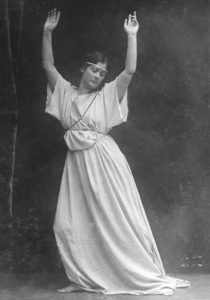
Isadora Duncan (Photo by: Sovfoto/Universal Images Group via Getty Images)
Arabella Mansfield (May 23, 1846) was born near Burlington, Iowa. Her birth name was Belle Aurelia Babb. In 1869 she was certified as an attorney, the first female attorney in America, although she never practiced law.
Ralph Waldo Emerson (May 25, 1803) was born in Boston, Massachusetts. An American philosopher and author, his works include Poems (1847, 1865), Representative Men (1850), Society and Solitude (1870), and much more.
Isadora Duncan (May 26, 1878) was born in San Francisco, California. She was an interpretive dancer who revolutionized the concept of dance by breaking tradition and performing barefoot in a loose-fitting tunic.
Al Jolson (May 26, 1886) was born in St. Petersburg, Russia as Asa Yoelson. He was an actor and singer who appeared in The Jazz Singer (1927) which was the first motion picture with full sound.
Wild Bill Hickok (May 27, 1837) was born in Troy Grove, Illinois. A frontiersman and lawman, he was also an army scout and gambler. He is best known for his Wild West shows. On August 2, 1876, he was shot during a poker game and died. In his hands were a pair of eights and a pair of aces which became known as the “dead man’s hand.”
Hubert H. Humphrey (May 27, 1911) was born in Wallace South Dakota. A liberal Democrat, he was vice president under Lyndon Johnson and ran for president against Richard Nixon but lost.
William Pitt the Younger (May 28, 1759) was born at Hayes, Kent, England. At the age of 24 he became British prime minister.
Jim Thorpe (May 28, 1888) was born near Prague, Oklahoma. He was a professional baseball and football player and won the pentathlon and decathlon events at the 1912 Olympic Games.